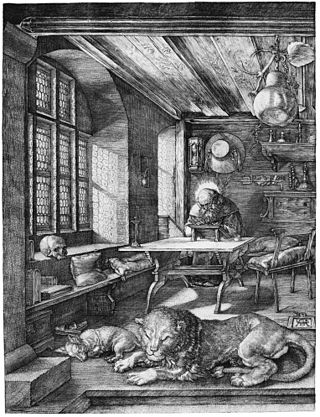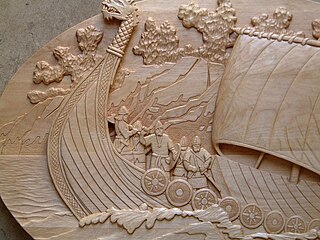Method
All leather needs to be prepared a certain way for leather carvers to carve the leather. The leather carver will "case" the leather by soaking it in water, then letting it dry to the proper dampness, thus making the leather easier to tool. If the leather is too dry, impressions will fade over time, or will not be made to a consistent depth. Too wet, it will not hold a sharply defined carving. Properly cased leather feels cool to the touch, and has the feel, of firm, wet clay. A damp sponge can be used to maintain the dampness while tooling but should never be used to replace proper casing.
Swivel knife cuts
When the leather has been properly cased, the swivel knife is used to make the bold cuts that form the backbone of the carved image. These cuts are made to a depth of up to approximately half the thickness of the leather being used, depending on the effect desired by the leather worker. Care must be taken during this step to keep the swivel knife vertical at all times, as any tilt is detrimental to the ability of the leather to be properly stamped later in the carving process.
Veiners, Seeders, and other Specific Tooling
Various other tools may be needed to add details to the carving depending on the pattern. Here is where the carver can add character, especially to floral carving.
Beveling
After shading is completed with the Pear Shader, the Beveler is used to compress one side of the cut. This creates the impression of depth by pressing down parts of the image relative to the foreground. The Beveler is used by holding it vertically, with the foot of the tool in contact with the leather, and striking it lightly with the rawhide mallet. The tool is then moved forward along the cut about half its width, and struck again with the mallet. This process is completed until the entire length of the cut has been appropriately beveled.
As a general rule, the outside of curves and the outside edge of anything overlapping another part of the design is beveled. The exception to this rule is leather that will later be stamped with another tool, and, if the background is to be treated with the background tool, the background itself.
Decorative cuts
This is the final step in creating a carved design. The swivel knife is again used to create small, decorative cuts in the design to enhance its appearance. These cuts may be made in parts of the design that have already been stamped, which is why it is necessary to leave this step until last.

A knife is a tool or weapon with a cutting edge or blade, usually attached to a handle or hilt. One of the earliest tools used by humanity, knives appeared at least 2.5 million years ago, as evidenced by the Oldowan tools. Originally made of wood, bone, and stone, over the centuries, in step with improvements in both metallurgy and manufacturing, knife blades have been made from copper, bronze, iron, steel, ceramic, and titanium. Most modern knives have either fixed or folding blades; blade patterns and styles vary by maker and country of origin.

Engraving is the practice of incising a design onto a hard, usually flat surface by cutting grooves into it with a burin. The result may be a decorated object in itself, as when silver, gold, steel, or glass are engraved, or may provide an intaglio printing plate, of copper or another metal, for printing images on paper as prints or illustrations; these images are also called "engravings". Engraving is one of the oldest and most important techniques in printmaking.

A chisel is a tool with a characteristically shaped cutting edge of blade on its end; for carving or cutting a hard material such as wood, stone, or metal by hand, struck with a mallet, or mechanical power. The handle and blade of some types of chisel are made of metal or wood with a sharp edge in it.

Wood carving is a form of woodworking by means of a cutting tool (knife) in one hand or a chisel by two hands or with one hand on a chisel and one hand on a mallet, resulting in a wooden figure or figurine, or in the sculptural ornamentation of a wooden object. The phrase may also refer to the finished product, from individual sculptures to hand-worked mouldings composing part of a tracery.

A peeler is a kitchen tool, a distinct type of kitchen knife, consisting of a metal blade with a slot with a sharp edge attached to a handle, used to remove the outer layer of some vegetables such as potatoes, broccoli stalks, and carrots, and fruits such as apples and pears. A paring knife may also be used to peel vegetables. The blade of a peeler has a slot with one side sharpened; the other side of the slot prevents the blade from cutting too far into the vegetable.

A Japanese kitchen knife is a type of a knife used for food preparation. These knives come in many different varieties and are often made using traditional Japanese blacksmithing techniques. They can be made from stainless steel, or hagane, which is the same kind of steel used to make Japanese swords. Most knives are referred to as hōchō or the variation -bōchō in compound words but can have other names including -kiri. There are four general categories used to distinguish the Japanese knife designs: handle, blade grind, steel, and construction.

Stone carving is an activity where pieces of rough natural stone are shaped by the controlled removal of stone. Owing to the permanence of the material, stone work has survived which was created during our prehistory or past time.

A drawknife is a traditional woodworking hand tool used to shape wood by removing shavings. It consists of a blade with a handle at each end. The blade is much longer than it is deep. It is pulled or "drawn" toward the user.

A miter saw or mitre saw is a saw used to make accurate crosscuts and miters in a workpiece by positioning a mounted blade onto a board. A miter saw in its earliest form was composed of a back saw in a miter box, but in modern implementation consists of a powered circular saw that can be positioned at a variety of angles and lowered onto a board positioned against a backstop called the fence.

A kitchen knife is any knife that is intended to be used in food preparation. While much of this work can be accomplished with a few general-purpose knives – notably a large chef's knife, a tough cleaver, a small paring knife and some sort of serrated blade – there are also many specialized knives that are designed for specific tasks. Kitchen knives can be made from several different materials.
In cooking, a chef's knife, also known as a cook's knife, is a cutting tool used in food preparation. The chef's knife was originally designed primarily to slice and disjoint large cuts of beef. Today it is the primary general-utility knife for most Western cooks.

Whittling may refer either to the art of carving shapes out of raw wood using a knife or a time-occupying, non-artistic process of repeatedly shaving slivers from a piece of wood. It is used by many as a pastime, or as a way to make artistic creations.
A seeder is a stamp-type leatherworking tool used in leather carving. It is predominantly used in floral designs to represent the seeds in the center of a flower, hence the name. Similar to other stamp-type tools, it is held vertically over the leather and struck with a wooden or rawhide mallet to create an impression in the surface of the leather. The seeder creates a small circular impression, often similar to an asterisk with a hole in the center.

In wood carving relief carving is a type in which figures or patterns are carved in a flat panel of wood; the same term is also used for carving in stone, ivory carving and various other materials. The figures project only slightly from the background rather than standing freely. Depending on the degree of projection, reliefs may also be classified as high or medium relief.
This glossary of woodworking lists a number of specialized terms and concepts used in woodworking, carpentry, and related disciplines.

Leather crafting or simply leathercraft is the practice of making leather into craft objects or works of art, using shaping techniques, coloring techniques or both.

A stone sculpture is an object made of stone which has been shaped, usually by carving, or assembled to form a visually interesting three-dimensional shape. Stone is more durable than most alternative materials, making it especially important in architectural sculpture on the outside of buildings.

A swivel knife is a chisel-edged blade held upright and mounted on a pivot with a saddle for a finger. It is held somewhat like a pencil, but between the thumb and middle fingers, while the forefinger rides in the saddle above. The saddle is free to rotate and in more sophisticated models, may rotate on ball bearings.
The splitting band knife is a kind of knife used in several fields including: tannery, EVA/rubber, foam, cork, shoe and leather goods, paper, carpet and other soft sheet materials. It is a power tool which is very similar in operation to a band saw, with an endless loop blade; the material to be cut is supported by a flat table.

Fruit carving is the art of carving fruit, a very common technique in Europe and Asian countries, and particularly popular in Thailand, China and Japan. There are many fruits that can be used in this process; the most popular one that artists use are watermelons, apples, strawberries, pineapples, and cantaloupes.


















